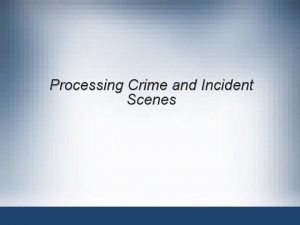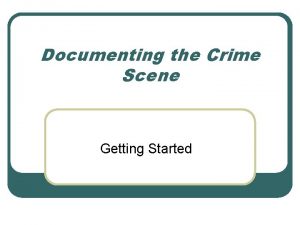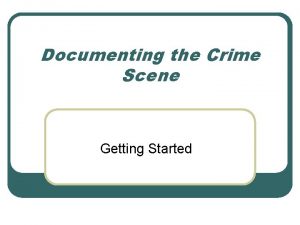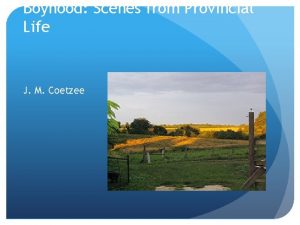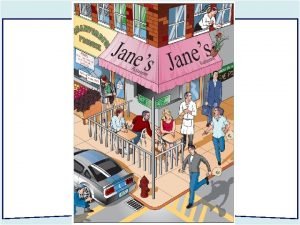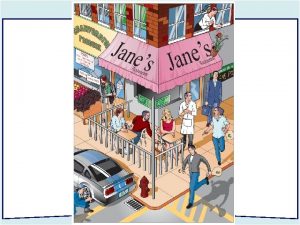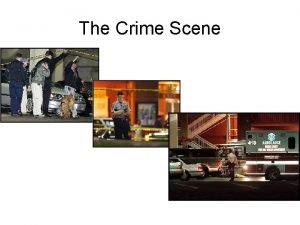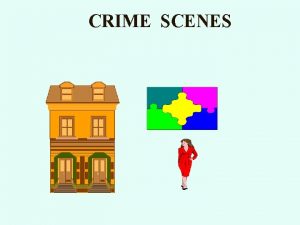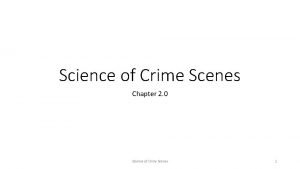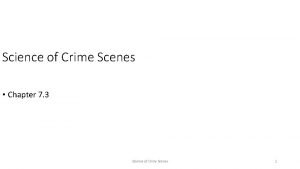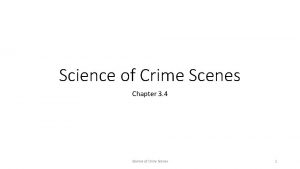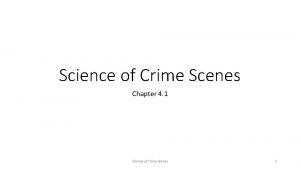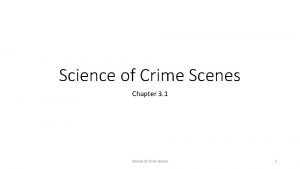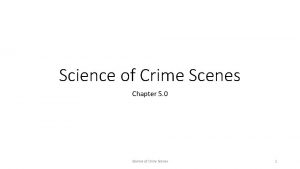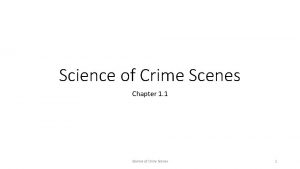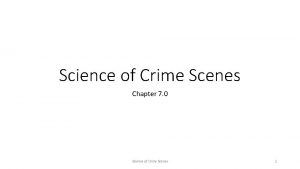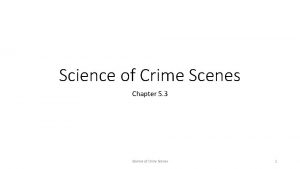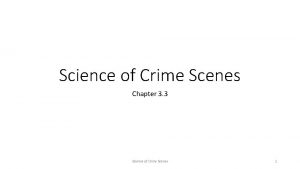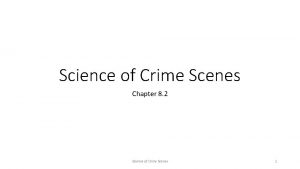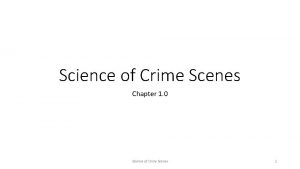Science of Crime Scenes Chapter 6 1 Science


















- Slides: 18

Science of Crime Scenes Chapter 6. 1 Science of Crime Scenes 1

Chemical evidence • The simple presence of some materials, like illegal drugs, could immediately inform the investigators of the criminal nature of the case • It could also provide intelligence about other factors or crimes Science of Crime Scenes 2

Drugs • A drug is a natural or manufactured substance that affects physiological or psychological behavior • Many are legally prescribed for therapeutic or medical purposes • Drugs present a particular crime scene problem • they may occur in amounts ranging from a few grams to kilos • New synthetic opioids, like fentanyl or carfentanil, present an even greater danger to CSIs • The lethal dose range for carfentanil is unknown but fentanyl is lethal at the 2 milligram range Science of Crime Scenes 3

Commonly Encountered Drugs of Abuse Effect Depressant Stimulant Hallucinogenic Drug Class Barbiturates Benzodiazepines Opiates Miscellaneous Cocaine Amphetamines Designer drugs Others Phenylethylamines Tryptamines Ergot alkaloids Cannabinoids Others Examples Butalbital, pentobarbital, phenobarbital Diazepam, oxazepam, flunitrazepam, temazepam Heroin, morphine, codeine Ethanol, fentanyl, dextropropoxyphene Cocaine, crack, ice Metamphetamine, amphetamine DOM, DOB, MBDB, MDA, MDE, MDMA Phenmetrazine, cathinone, methcathinone, khat Mescaline DMT, psilocybin, psilocin LSD Hashish, marijuana, cannabis PCP Science of Crime Scenes 4

Testing large amounts of bulk material • Large amounts of drugs pose questions about sampling • In the field, a positive presumptive test is required for seizure, but how much is required to be tested? • Start with the hypothesis that the bulk of material consists wholly of either illicit drugs or no illegal substances at all • One positive result out of five random samples from the larger population is enough to state with a high degree of confidence that at least half of the seizure is either a genuine drug or not • Additional sampling can take place in the laboratory Science of Crime Scenes 5

Presumptive spot tests • Commercial kits provide a flowchart to identify the presumptive drugs encountered • Example, NIK® tests • Easy, cheap, safe • These kits may have a questionable quality control history • In one investigative report, one large municipality reported 21 % of evidence that the police listed as methamphetamine after identifying it was not methamphetamine, and half of those false positives were not any kind of illegal drug at all • A more rigorous protocol follows Science of Crime Scenes 6

Despite the rigor, these are still presumptive tests Science of Crime Scenes 7

Arson • Fire scene examination aims: • • To detect the cause of the fire The point of ignition Any accelerants or ignitable liquids that may have been used The pattern of the damage • Fire can only occur and persist in the presence of three parameters: heat, fuel, and oxygen • A crime itself, often committed to cover another crime, like murder, theft, or fraud • Many myths abound about fire scene indicators, like crazed glass or “fire trails” Science of Crime Scenes 8

Arson scenes are difficult because of the damage Science of Crime Scenes 9

Relevant clues to infer the site of ignition • The area of maximum damage. • Depth of charring to wood as compared with different places with similar wood. • Spalling of plaster combined with a smoke pattern on the underlying wall; spalling without the smoke pattern could be due to firefighting techniques. • Distortion to glass (700– 900°C), plastic (130– 400°C), PVC (60– 120°C), metalwork (300– 1, 000°C, depending of the type of metal) may also be relevant, as well as damage to concrete floors and ceilings. • Residual heat in a lower-level burning region (as fire generally spreads upwards). • A V-funnel pattern. Science of Crime Scenes 10

Temperatures of interest Matter T° of Ignition Hay 150 Wood 150 -250 PVC 370 -390 PET 410 Polyester, Nylon 500 Melamine 790 Animal wool 600 Cotton 400 Hydrogen 400 Butane 404 Propane 450 Natural gas 482 -632 Ethylene 490 Ethane 515 Methane 540 CO 605 Science of Crime Scenes 11

Temperatures of interest Matter T° of Fusion Tin 230 Lead 327 Zinc 420 Magnesium 650 Aluminium 660 Bronze 699 -1032 Brass 854 -1038 Silver 961 Gold 1024 Copper 1083 Steel, Iron, Cast iron 1200 -1500 Glass 1350 -1500 Nickel 1642 Platinum 1769 Chrome 1875 Science of Crime Scenes 12

Explosives • An explosive is defined as a compound able to undergo a rapid chemical change without an outside supply of oxygen, liberating a large quantity of energy, generally in the form of hot gases and a high -pressure wave • An explosion is basically a very fast fire • Three main types • Commercial • Military • Improvised/homemade Science of Crime Scenes 13

Improvised explosive devices (IEDs) • Can be crudely made or quite sophisticated • It is the immediate needs and resources of the bomber that creates its traceability • • • Housing Materials used to make the bomb Explosives Primers Shrapnel Science of Crime Scenes 14

The crater of explosion requires the most painstaking search Science of Crime Scenes 15

The crater of explosion requires the most painstaking search • Swabs of the immediate surfaces facing the crater • A close search of the crater and its nearby surrounding area • A removal of all the debris inside and around the crater • A measure of the crater’s volume • Multiple soil samples taken around the crater Science of Crime Scenes 16

Restoration of serial numbers • Many manufactured goods are tagged during production for identification by the company that made them or their partner companies • Criminals may attempt to obliterate or remove this identifying information • Restoration of the prime serial number may still be possible as long as the damaged area under the marked serial number was not also removed • These tests are best done in the laboratory but the numbers (or their obliteration efforts) can be identified at the scene Science of Crime Scenes 17

Serial number on metal part Science of Crime Scenes 18
 Processing crime and incident scenes
Processing crime and incident scenes Sketch all serious crime and crash scenes:
Sketch all serious crime and crash scenes: Sketch of locality in crime scene
Sketch of locality in crime scene Painting underwater scenes
Painting underwater scenes Does juliet wake up just before romeo dies or just after
Does juliet wake up just before romeo dies or just after Macbeth act 1 summary scenes 1-7
Macbeth act 1 summary scenes 1-7 Three bears chairs
Three bears chairs Doctor faustus act 2 scene 1
Doctor faustus act 2 scene 1 The passion of the christ behind the scenes
The passion of the christ behind the scenes Preface from behind the scenes
Preface from behind the scenes How does this scene prepare the reader for future scenes?
How does this scene prepare the reader for future scenes? Pros and cons of george killing lennie
Pros and cons of george killing lennie Summary of macbeth act 4
Summary of macbeth act 4 Scene by scene summary of macbeth
Scene by scene summary of macbeth Hamlet act 4
Hamlet act 4 Semantica dei frame
Semantica dei frame Boyhood scenes from provincial life
Boyhood scenes from provincial life Lesson 7 act 3 scenes 1-3
Lesson 7 act 3 scenes 1-3 The theme of fate in romeo and juliet
The theme of fate in romeo and juliet
